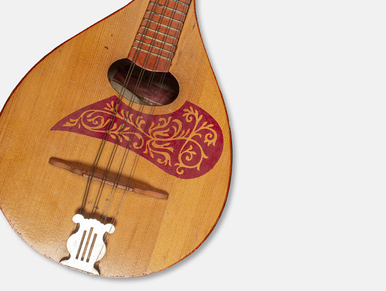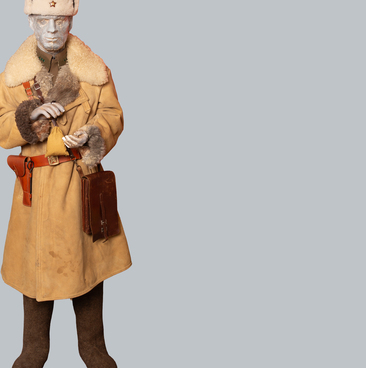The exhibit is a mannequin of a Red Army soldier in combat uniform typical of the winter of 1941–1942. This was how most of the Red Army soldiers, commanders and political officers that were at that time retreating looked.
Most warehouses and enterprises with pre-war goods and equipment were destroyed at the beginning of the war. There was a decline in the output of light industry products, as some of the evacuated enterprises had not yet established production, and the remaining ones experienced difficulties with raw materials, energy and workforce.
In order to accelerate production and save materials, deviations from pre-war models were allowed, and various substitutes for natural materials were used. The uniform of that period was simple, durable, cheap and easy to produce.
The gray ushanka had a visor and ear flaps, made of artificial fur. The visor of the hat was either fastened with two metal buttons, or attached to the hat’s crown with threads in two places. A metal star covered with green enamel was placed in the center of the visor.
Uniform boots were army ankle boots. The outsole was attached to the insole and the upper with screws or wooden pins. The boots were made of leather or various types of leatherette. They were worn with knitted cotton puttees that covered the upper part of the boot up to the knee.
Most Red Army soldiers met the first winter of the Great Patriotic War wearing thin summer boots and puttees: the production of winter boots had not yet been established. The infantry wore them throughout the war until the victorious 1945.
Personal belongings of a Red Army soldier were kept in a duffel bag. It was made of camouflage tarpaulin. Handles sewn from a single ribbon of a lighter tone were attached to the front and back in the center. The top of the bag was closed with a drawstring. There was also a rectangular pocket. The bag had only one compartment.
The bag was part of the sets of field equipment of the rank and file or junior officers. It was supposed to be used for up to eight years. The material could vary, but basically it was made of different types of waterproof tent fabric. Officially, it was called the “duffel bag of the Turkestan type” or “duffel bag of the 1930 model”. Soldiers nicknamed it “sidor”.


